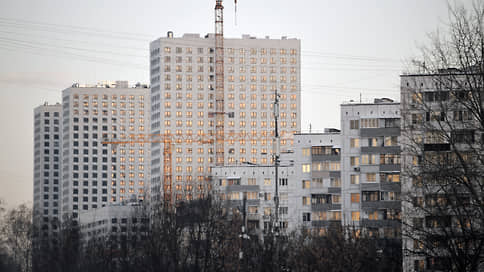Mortgages have cooled buyers – Kommersant
[ad_1]

The pronounced increase in prices for new buildings in the largest regional markets of the country began to slow down: over the month their average cost increased by 1.6–1.9%. Cooling is facilitated by a reduction in demand and an increase in supply. The key event for the segment in the near future may be a significant tightening of the conditions for issuing preferential mortgage loans, due to which 25–30% of buyers will leave the market. This may contribute to a further decline in sales, to which developers will be forced to respond by providing discounts. The decline in the rate of sales of secondary housing will also put pressure on the segment of new buildings.
The average cost of new buildings in the 18 largest regional markets of Russia (16 cities with a population of over a million, Moscow and Leningrad regions) at the beginning of December amounted to 162.6 thousand rubles. per sq. m, increasing by 1.6% per month, was calculated in CIAN.Analyst. Despite the growth in the indicator, the company speaks of a gradual cooling of the market: over the previous month, prices for primary housing increased by an average of 2.4%. According to Etazhi data, new buildings in the country as a whole rose in price over the month by 1.9%, to 124.5 thousand rubles. per sq. m. By December last year, the growth was 6%. Avito Real Estate adds that the average cost of a lot is 6.5 million rubles. Over the month, the figure increased by 2.1%, over the year – by 7.8%.
Most noticeable average initial offer price for the month, according to CIAN.Analytics, grew up in Voronezh: by 4.3%, to 109.4 thousand rubles. per sq. m. In Nizhniy Novgorod the same dynamics amounted to 3.5%, to 183.2 thousand rubles. per sq. m. Avito Real Estate notes an increase in the average indicator of 5.1% per month in Krasnodar, up to 154.2 thousand rubles. per sq. m. Similar dynamics, according to the service, In Ekaterinburg — increase by 5%, to 142.1 thousand rubles. per sq. m. In Volgograd the increase, according to Etazhi, was 3.8%, to 93.7 thousand rubles.
In Moscow the average cost of new buildings at the beginning of December, according to CIAN.Analytics, amounted to 347.8 thousand rubles. per sq. m. Over the month, the value increased by 1.5%, over the year – by 9%. In St. Petersburg similar dynamics amounted to 0.2% and 8%, respectively, to 255.6 thousand rubles. per sq. m.
The volume of exposure on the market is growing. According to calculations by CIAN.Analytics, 172 thousand lots were available in new buildings in the country’s largest regional markets at the beginning of December, 2% more than a month earlier. “Developer activity has decreased slightly after record volumes of new product launches in September-October, but still remains above the average for the last two years,” says Alexey Popov, head of CIAN.Analytics. The head of the primary direction of Avito Real Estate, Dmitry Alekseev, says that over the month the volume of supply increased by 7.2%, over the year – by 46.3%.
The process is due not only to the strategy of the developers, but also to the cooling of demand: the activity of potential buyers over the past month decreased by 7.3%.
Sales Director of Etazhey Sergey Zaitsev draws attention to the fact that the current activity of buyers is still largely supported by a significant increase in the cost of lending in the secondary market, while preferential programs remain in the primary market.
But the key event for the primary market in the near future will be the possible tightening of conditions for issuing preferential mortgage loans. This week the Ministry of Finance contributed a draft proposal has been submitted to the government, providing for an increase in the minimum down payment from 20% to 30%, a reduction in the maximum loan size in Moscow, St. Petersburg and surrounding areas from 12 million to 6 million rubles, limiting the number of concessional loans issued and more stringent requirements for borrowers .
Alexey Popov believes that the initiative will “remove” 25–30% of potential buyers from the market. Mainly due to a reduction in the share of lots in the capital regions that can participate in the program and increased requirements for the borrowers themselves. This will force developers to move away from regular price indexation and more actively provide discounts. Although in the short term, the situation, according to Mr. Popov, may result in another wave of excitement and the implementation of advanced demand, which, in turn, will cause an increase in average prices due to the washing out of the most budget offers. Sergei Zaitsev recalls that this is how buyers reacted to the protective measures in 2022.
Although Dmitry Alekseev reminds that the last surge in demand on the market ended quite recently.
The expert does not expect a new revival in the absence of government incentive measures, counting on a decline in sales until the end of the year.
Before the start of the holidays, developers will traditionally try to whet the interest of buyers with the help of various discounts and promotions. At the beginning of the year, according to Mr. Zaitsev’s forecasts, the market will also cool down. “We do not expect prices to decline; rather, they will be fixed in their occupied positions, and then will rise at the level of real inflation,” he argues. In his opinion, sales of new buildings will be most significantly affected by the situation on the secondary market: to buy primary housing, people often sell their existing real estate; if this is not easy to do, the sales of developers will automatically decrease.
[ad_2]
Source link





